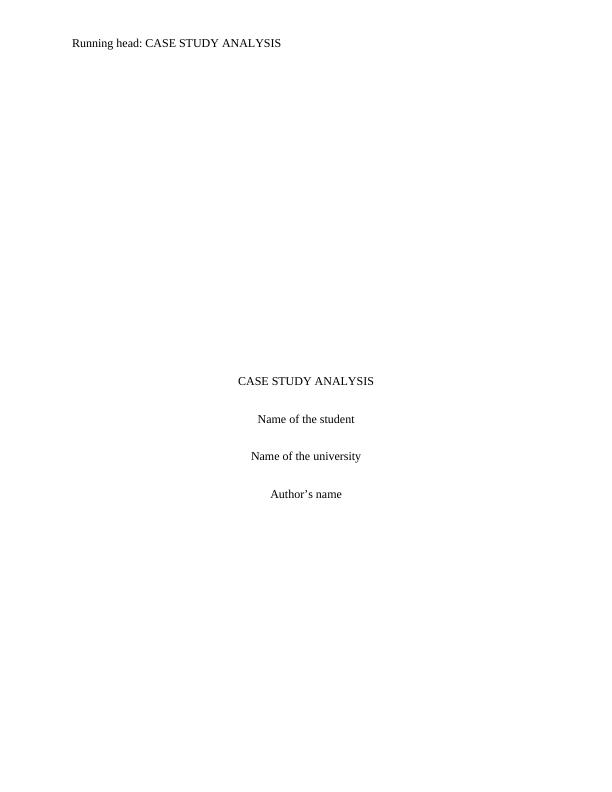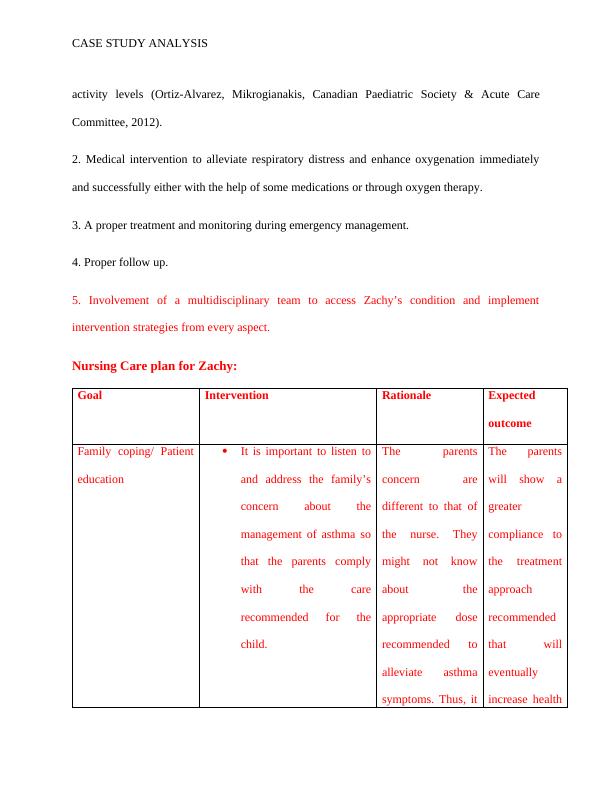Case Study Analysis of Asthma
Added on 2022-08-26
11 Pages2258 Words16 Views
Running head: CASE STUDY ANALYSIS
CASE STUDY ANALYSIS
Name of the student
Name of the university
Author’s name
CASE STUDY ANALYSIS
Name of the student
Name of the university
Author’s name

CASE STUDY ANALYSIS
Introduction
Asthma is characterised by the function of airways in combination with airway
hyperresponsiveness (AHR) and inflammation. Asthma is a reversible airflow barrier. More than
300 million people in the world suffer from the disease, with about 250,000 deaths annually. The
mortality of asthma has decreased over the last few decades since the inhaled corticosteroid
became the main asthma treatment agent. In the past half decades, over conjunction with
urbanization, respiratory conditions such as asthma have dramatically risen. By contrast to other
age categories, children have the highest proportion of asthma. Therefore, by 2025 the number of
patients is expected to grow by over 100 million (Kudo, Ishigatsubo & Aoki, 2013). In this
paper, the pathophysiology of childhood Asthma and its effective management will be discussed
with the help of a case study given.
Discussion
Part-A
Pathophysiology of Asthma:
Asthma is referred to as a chronic inflammatory disorder of the airways. It is a pulmonary
condition characterised with chronic inflammation of the respiratory tubes, respiratory smooth
muscle tightening and an episode of bronchoconstriction (Félix et al., 2020). Inflamed airways
respond to environmental triggers including smoke, dust, or pollen throughout an asthma
episode. The airways are narrowing and producing excess mucus, making breathing difficult.
Essentially, asthma in the bronchial airways is the result of an immune response. Asthma patients
Introduction
Asthma is characterised by the function of airways in combination with airway
hyperresponsiveness (AHR) and inflammation. Asthma is a reversible airflow barrier. More than
300 million people in the world suffer from the disease, with about 250,000 deaths annually. The
mortality of asthma has decreased over the last few decades since the inhaled corticosteroid
became the main asthma treatment agent. In the past half decades, over conjunction with
urbanization, respiratory conditions such as asthma have dramatically risen. By contrast to other
age categories, children have the highest proportion of asthma. Therefore, by 2025 the number of
patients is expected to grow by over 100 million (Kudo, Ishigatsubo & Aoki, 2013). In this
paper, the pathophysiology of childhood Asthma and its effective management will be discussed
with the help of a case study given.
Discussion
Part-A
Pathophysiology of Asthma:
Asthma is referred to as a chronic inflammatory disorder of the airways. It is a pulmonary
condition characterised with chronic inflammation of the respiratory tubes, respiratory smooth
muscle tightening and an episode of bronchoconstriction (Félix et al., 2020). Inflamed airways
respond to environmental triggers including smoke, dust, or pollen throughout an asthma
episode. The airways are narrowing and producing excess mucus, making breathing difficult.
Essentially, asthma in the bronchial airways is the result of an immune response. Asthma patients

CASE STUDY ANALYSIS
' airways are "hypersensitive" to some triggers, also referred to as stimuli. Typically it is graded
as type I hype (Félix et al., 2020).
The most commonly understood causative factors are the pathways causing allergic
asthma, i.e., immune response to inhaled allergens. A variety of cell called antigen-prone cells or
APCs is absorbed in both individuals with asthma as well as in people who are free from the
disorder (Herzog & Cunningham‐Rundles, 2011). Inhaled allergens are present to the inner
airways these other immune cells in most individuals search and usually ignore allergens in the
other immune (TH0 cells). However, for reasons which are not well-comprehended, these cells
in asthma patients transform into a different type of cell (TH2). A potential reason may be that
Interleukin-4 is released to Mast cells which induce the differentiation between Th2 cells of
naive T support cells (Th0 cells) (Kudo, Ishigatsubo & Aoki, 2013).
Asthma in children can trigger troublesome everyday symptoms, interfering with
exercise, playing, school and sleep. Unmanaged asthma can lead to dangerous attacks on asthma
in some children. Common signs and symptoms for childhood asthma include frequent coughing
that gets worse when the child suffers from a viral infection, whistling or sound while breathing
out, shortness of breath or chest congestion or tightness which were evident in Zachy.
Part- B
Prioritised care plan for Zachy:
1. An urgent and accurate assessment of his severity by assessing his vitals. Focused physical
evaluation to measure the functional extent of the airway obstruction, to monitor the function of
accessory muscles, the air intake in both the lungs and wheezing, the alertness, speech and
' airways are "hypersensitive" to some triggers, also referred to as stimuli. Typically it is graded
as type I hype (Félix et al., 2020).
The most commonly understood causative factors are the pathways causing allergic
asthma, i.e., immune response to inhaled allergens. A variety of cell called antigen-prone cells or
APCs is absorbed in both individuals with asthma as well as in people who are free from the
disorder (Herzog & Cunningham‐Rundles, 2011). Inhaled allergens are present to the inner
airways these other immune cells in most individuals search and usually ignore allergens in the
other immune (TH0 cells). However, for reasons which are not well-comprehended, these cells
in asthma patients transform into a different type of cell (TH2). A potential reason may be that
Interleukin-4 is released to Mast cells which induce the differentiation between Th2 cells of
naive T support cells (Th0 cells) (Kudo, Ishigatsubo & Aoki, 2013).
Asthma in children can trigger troublesome everyday symptoms, interfering with
exercise, playing, school and sleep. Unmanaged asthma can lead to dangerous attacks on asthma
in some children. Common signs and symptoms for childhood asthma include frequent coughing
that gets worse when the child suffers from a viral infection, whistling or sound while breathing
out, shortness of breath or chest congestion or tightness which were evident in Zachy.
Part- B
Prioritised care plan for Zachy:
1. An urgent and accurate assessment of his severity by assessing his vitals. Focused physical
evaluation to measure the functional extent of the airway obstruction, to monitor the function of
accessory muscles, the air intake in both the lungs and wheezing, the alertness, speech and

CASE STUDY ANALYSIS
activity levels (Ortiz-Alvarez, Mikrogianakis, Canadian Paediatric Society & Acute Care
Committee, 2012).
2. Medical intervention to alleviate respiratory distress and enhance oxygenation immediately
and successfully either with the help of some medications or through oxygen therapy.
3. A proper treatment and monitoring during emergency management.
4. Proper follow up.
5. Involvement of a multidisciplinary team to access Zachy’s condition and implement
intervention strategies from every aspect.
Nursing Care plan for Zachy:
Goal Intervention Rationale Expected
outcome
Family coping/ Patient
education
It is important to listen to
and address the family’s
concern about the
management of asthma so
that the parents comply
with the care
recommended for the
child.
The parents
concern are
different to that of
the nurse. They
might not know
about the
appropriate dose
recommended to
alleviate asthma
symptoms. Thus, it
The parents
will show a
greater
compliance to
the treatment
approach
recommended
that will
eventually
increase health
activity levels (Ortiz-Alvarez, Mikrogianakis, Canadian Paediatric Society & Acute Care
Committee, 2012).
2. Medical intervention to alleviate respiratory distress and enhance oxygenation immediately
and successfully either with the help of some medications or through oxygen therapy.
3. A proper treatment and monitoring during emergency management.
4. Proper follow up.
5. Involvement of a multidisciplinary team to access Zachy’s condition and implement
intervention strategies from every aspect.
Nursing Care plan for Zachy:
Goal Intervention Rationale Expected
outcome
Family coping/ Patient
education
It is important to listen to
and address the family’s
concern about the
management of asthma so
that the parents comply
with the care
recommended for the
child.
The parents
concern are
different to that of
the nurse. They
might not know
about the
appropriate dose
recommended to
alleviate asthma
symptoms. Thus, it
The parents
will show a
greater
compliance to
the treatment
approach
recommended
that will
eventually
increase health

End of preview
Want to access all the pages? Upload your documents or become a member.
Related Documents
Case Study on Asthmalg...
|9
|2383
|50
Body Integrity Assignment PDFlg...
|5
|1450
|42
Asthma Pathophysiology | Nursing Assignmentlg...
|11
|3811
|19
Pharmacology and Pathophysiologylg...
|12
|3125
|20
Pathophysiology of Asthma and Clinical Manifestations: A Case Studylg...
|8
|1938
|93
Management of Asthma: Case Study on John Brownlg...
|15
|1309
|387
